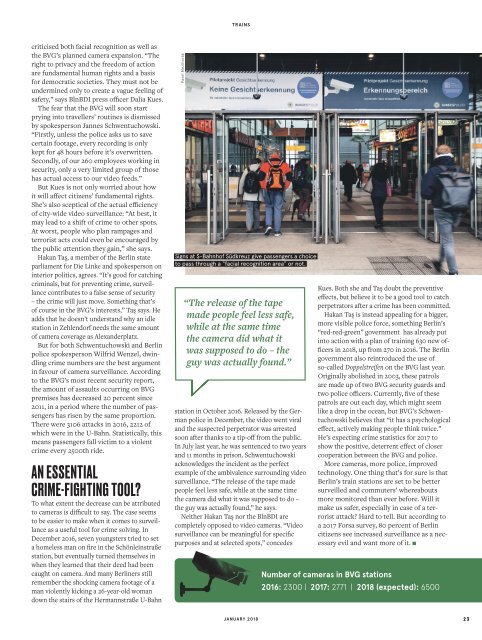Exberliner Issue 167, January 2018
Create successful ePaper yourself
Turn your PDF publications into a flip-book with our unique Google optimized e-Paper software.
TRAINS<br />
criticised both facial recognition as well as<br />
the BVG’s planned camera expansion. “The<br />
right to privacy and the freedom of action<br />
are fundamental human rights and a basis<br />
for democratic societies. They must not be<br />
undermined only to create a vague feeling of<br />
safety,” says BlnBDI press officer Dalia Kues.<br />
The fear that the BVG will soon start<br />
prying into travellers’ routines is dismissed<br />
by spokesperson Jannes Schwentuchowski.<br />
“Firstly, unless the police asks us to save<br />
certain footage, every recording is only<br />
kept for 48 hours before it’s overwritten.<br />
Secondly, of our 260 employees working in<br />
security, only a very limited group of those<br />
has actual access to our video feeds.”<br />
But Kues is not only worried about how<br />
it will affect citizens’ fundamental rights.<br />
She’s also sceptical of the actual efficiency<br />
of city-wide video surveillance: “At best, it<br />
may lead to a shift of crime to other spots.<br />
At worst, people who plan rampages and<br />
terrorist acts could even be encouraged by<br />
the public attention they gain,” she says.<br />
Hakan Taş, a member of the Berlin state<br />
parliament for Die Linke and spokesperson on<br />
interior politics, agrees. “It’s good for catching<br />
criminals, but for preventing crime, surveillance<br />
contributes to a false sense of security<br />
– the crime will just move. Something that’s<br />
of course in the BVG’s interests,” Taş says. He<br />
adds that he doesn’t understand why an idle<br />
station in Zehlendorf needs the same amount<br />
of camera coverage as Alexanderplatz.<br />
But for both Schwentuchowski and Berlin<br />
police spokesperson Wilfrid Wenzel, dwindling<br />
crime numbers are the best argument<br />
in favour of camera surveillance. According<br />
to the BVG’s most recent security report,<br />
the amount of assaults occurring on BVG<br />
premises has decreased 20 percent since<br />
2011, in a period where the number of passengers<br />
has risen by the same proportion.<br />
There were 3106 attacks in 2016, 2212 of<br />
which were in the U-Bahn. Statistically, this<br />
means passengers fall victim to a violent<br />
crime every 2500th ride.<br />
AN ESSENTIAL<br />
CRIME-FIGHTING TOOL?<br />
To what extent the decrease can be attributed<br />
to cameras is difficult to say. The case seems<br />
to be easier to make when it comes to surveillance<br />
as a useful tool for crime solving. In<br />
December 2016, seven youngsters tried to set<br />
a homeless man on fire in the Schönleinstraße<br />
station, but eventually turned themselves in<br />
when they learned that their deed had been<br />
caught on camera. And many Berliners still<br />
remember the shocking camera footage of a<br />
man violently kicking a 26-year-old woman<br />
down the stairs of the Hermannstraße U-Bahn<br />
Pavel Mezihorák<br />
Signs at S-Bahnhof Südkreuz give passengers a choice<br />
to pass through a “facial recognition area” or not.<br />
“The release of the tape<br />
made people feel less safe,<br />
while at the same time<br />
the camera did what it<br />
was supposed to do – the<br />
guy was actually found.”<br />
station in October 2016. Released by the German<br />
police in December, the video went viral<br />
and the suspected perpetrator was arrested<br />
soon after thanks to a tip-off from the public.<br />
In July last year, he was sentenced to two years<br />
and 11 months in prison. Schwentuchowski<br />
acknowledges the incident as the perfect<br />
example of the ambivalence surrounding video<br />
surveillance. “The release of the tape made<br />
people feel less safe, while at the same time<br />
the camera did what it was supposed to do –<br />
the guy was actually found,” he says.<br />
Neither Hakan Taş nor the BlnBDI are<br />
completely opposed to video cameras. “Video<br />
surveillance can be meaningful for specific<br />
purposes and at selected spots,” concedes<br />
Kues. Both she and Taş doubt the preventive<br />
effects, but believe it to be a good tool to catch<br />
perpetrators after a crime has been committed.<br />
Hakan Taş is instead appealing for a bigger,<br />
more visible police force, something Berlin’s<br />
“red-red-green” government has already put<br />
into action with a plan of training 630 new officers<br />
in <strong>2018</strong>, up from 270 in 2016. The Berlin<br />
government also reintroduced the use of<br />
so-called Doppelstreifen on the BVG last year.<br />
Originally abolished in 2003, these patrols<br />
are made up of two BVG security guards and<br />
two police officers. Currently, five of these<br />
patrols are out each day, which might seem<br />
like a drop in the ocean, but BVG’s Schwentuchowski<br />
believes that “it has a psychological<br />
effect, actively making people think twice.”<br />
He’s expecting crime statistics for 2017 to<br />
show the positive, deterrent effect of closer<br />
cooperation between the BVG and police.<br />
More cameras, more police, improved<br />
technology. One thing that’s for sure is that<br />
Berlin’s train stations are set to be better<br />
surveilled and commuters’ whereabouts<br />
more monitored than ever before. Will it<br />
make us safer, especially in case of a terrorist<br />
attack? Hard to tell. But according to<br />
a 2017 Forsa survey, 80 percent of Berlin<br />
citizens see increased surveillance as a necessary<br />
evil and want more of it. n<br />
Number of cameras in BVG stations<br />
2016: 2300 | 2017: 2771 | <strong>2018</strong> (expected): 6500<br />
JANUARY <strong>2018</strong><br />
23


















